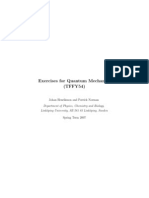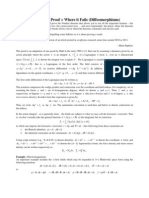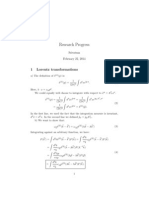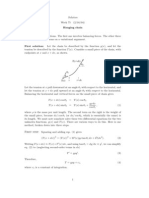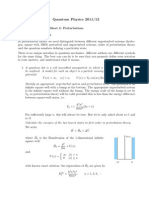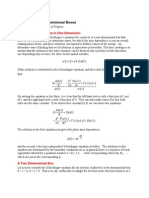Double Well Quantum Mechanics: 1 The Nonrelativistic Toy Problem
Double Well Quantum Mechanics: 1 The Nonrelativistic Toy Problem
Uploaded by
Gautam SharmaOriginal Description:
Original Title
Copyright
Available Formats
Share this document
Did you find this document useful?
Is this content inappropriate?
Report this DocumentCopyright:
Available Formats
Double Well Quantum Mechanics: 1 The Nonrelativistic Toy Problem
Double Well Quantum Mechanics: 1 The Nonrelativistic Toy Problem
Uploaded by
Gautam SharmaCopyright:
Available Formats
Double Well Quantum Mechanics
Steven G. Avery
The double well potential is a rich toy example for understanding numerous quan-
tum mechanical systems. At the time I made these notes, I was actually motivated by
thinking about the decoupling limit and the AdSCFT correspondence. Here, I outline
a method for modeling the double well dynamics that I have not seen elsewhere in the
literature. The standard reference I know (which uses instantons) is in Colemans Aspects
of Symmetry, the chapter titled The double well done doubly well.
We want to think of perturbatively relaxing the limit in which the barrier is innitely
high, and there is no tunneling. To do this we wish to add interaction terms which annih-
late a particle in the left well and create a particle in the right well (and vice-versa).
1 The Nonrelativistic Toy Problem
We want to consider non-interacting non-relativistic particles in the potential
x
1
x
2
x
3
V
U
V (x) =
_
_
0 0 < x x
1
U x
1
< x x
2
V
0
x
2
< x x
3
otherwise
. (1)
For convenience we dene
x
1
= L
1
x
2
x
1
= a x
3
x
2
= L
2
. (2)
1
Double Well Steven G. Avery
Our ultimate goal is to approximate this problem as two isolated square wells of widths
L
1
and L
2
with some small interaction. This description should be valid for energies, E,
such that
0 < V
0
< E U. (3)
For simplicity, we set L
1
= L
2
= L.
The interaction should annihlate a particle in the left well and create a particle in the
right well (and vice-versa). Thus, this problem naturally requires the use of a multi-
particle formulation of nonrelativistic quantum mechanics.
We rst review how to second quantize the schrodinger equation to nd such a
description. Then, we argue that one can drop the time-derivative kinetic term of the
action in the barrier region and integrate out those degrees of freedom. This removes the
barrier region of the action, but leaves behind boundary terms.
The boundary terms dene nonvanishing boundary conditions for the interior edges
of the two decouopled wells, and provide a coupling term. We treat the coupling term as
a perturbation. To zeroeth order, then, one can neglect it and canonically quantize the two
wells separately. Finally, one sees with what strength the coupling term couples modes
in the left mode to modes in the right well.
2 Second Quantized Schrodinger Equation
Note that the Lagrangian
L =
i
2
_
1
2m
V (x)
(4)
has the Schrodinger Equation,
i
=
1
2m
2
+V (x), (5)
and its Hermitian conjugate as its equation of motion.
We wish to canonically quantize this theory to describe multiparticle nonrelativistic
quantum mechanics. We begin by nding the canonical momenta
=
L
=
i
2
=
L
=
i
2
, (6)
which give us two primary constraints
1
=
i
2
2
=
+
i
2
. (7)
The naive Hamiltonian has no kinetic term,
H
N
=
+
L
=
1
2m
+V (x)
, (8)
double-well.tex 2 January 12, 2010, 7:15pm
Double Well Steven G. Avery
a key hint that we need to use Diracs generalization of Hamiltonian mechanics.
The two primary constraints are second-class and generate no secondary constraints.
The total Hamiltonian is given by
H = H
N
+u
1
1
+u
2
2
. (9)
Demanding that
1
=
1
, H
P.B.
= 0 (weakly), (10)
xes one of the arbitrary functions
u
2
= iV (x)
, (11)
and similarly one nds from the other consistency condition that
u
1
= iV (x). (12)
Since we are interested in quantizing the system, we nd the canonical Dirac brackets
and then we can use the naive Hamiltonian. The Dirac brackets are dened by
f, g
D.B.
= f, g
P.B.
f,
i
P.B.
_
M
1
_
ij
j
, g
P.B.
, (13)
where
M
ij
=
i
,
j
P.B.
= (
2
)
ij
= i
ij
=
_
M
1
_
ij
. (14)
One nds that the nonvanishing canonical Dirac brackets are
(x),
(y)
D.B.
= i(x y)
(x), (y)
D.B.
=
1
2
(x y)
(x),
(y)
D.B.
=
1
2
(x y).
(15)
Upon canonically quantizing, then, one can describe the system as
H =
1
2m
+V (x)
(x),
(y)] = (x y). (16)
Suppose that there is some complete set of orthonormal solutions to the classical
energy-eigenvalue wave equation:
E
n
, f
n
1
2m
f
n
+V (x)f
n
= E
n
f
n
. (17)
We can expand
in these modes as
(x) =
n
a
n
f
n
(x) [ a
m
, a
n
] =
mn
. (18)
double-well.tex 3 January 12, 2010, 7:15pm
Double Well Steven G. Avery
The Hamiltonian becomes
H =
m,n
a
m
a
n
_
dx
_
1
2m
f
n
+V (x)f
n
_
f
m
=
m,n
E
n
a
m
a
n
_
dx f
n
f
m
=
n
E
n
a
n
a
n
. (19)
3 Integrating out Barrier Degrees of Freedom
We can formally break the action into three parts
S
tot.
= S
1
+S
barrier
+S
2
=
_
dt
_
L
0
dxL +
_
dt
_
L+a
L
dxL +
_
dt
_
2L+a
L+a
dxL (20)
3.1 Integrating out the Barrier
We now want to use our assumption that the energies under consideration are much
smaller than the potential energy in the barrier region
E
typ.
U. (21)
Consider that
e
iEt
,
and therefore
L
B
=
i
2
_
1
2m
V (x)
= (E U)
1
2m
1
2m
V (x)
. (22)
In this approximation, we have replaced E U U, and thereby dropped the kinetic
term. By dropping the kinetic term, we have made the barrier degrees of freedom non-
dynamical. We can integrate them out as auxillary variables by solving the equation of
motion and then plugging it back into the action.
For this 1 +1-dimensional example, the equation for the barrier degrees of freedom is
(x) = 2mU(x) L < x < L +a, (23)
which has a solutions of the form
(x) = Acosh
_
2mU(x L)
_
+Bsinh
_
2mU(x L)
_
. (24)
double-well.tex 4 January 12, 2010, 7:15pm
Double Well Steven G. Avery
We can eliminate A and B in terms of the boundary degrees of freedom by using
A = (L)
B = (L +a) csch(
2mUa) (L) coth(
2mUa).
(25)
We then plug this into the barrier Lagrangian,
L
B
=
_
L+a
L
L
B
[], (26)
to nd
L
B
=
_
U
2m
coth(
2mUa)
_
(L)(L) +
(L +a)(L +a)
_
+
_
U
2m
1
sinh(
2mUa)
_
(L)(L +a) +
(L +a)(L)
_
.
(27)
The rst term provides the boundary conditions of the solution in the two regions inde-
pendently, whereas the second term provides the coupling between the two wells.
3.2 Solving the two regions with boundary terms
We wish to work in a the limit where the second term is a small effect and can be treated
perturbatively. In which case, the unperturbed action for the left region is given by
S
1
=
_
dt
_
L
0
dx
_
i
2
(
)
1
2m
_
U
2m
coth(
2mUa)
_
dt
(L)(L).
(28)
To determine the equations of motion we should demand that the linear variation of the
action under arbitrary variations of and
vanishes. The variations and
must be
subject to appropriate boundary conditions. In this case, we should leave the right edge
unconstrained while the left edge should vanish.
Therefore, we must be careful to not drop all of the boundary terms when integrating
by parts. One nds
S =
_
dt
_
L
0
dx
_
i
+
1
2m
_
dt
_
1
2m
(L) +
_
U
2m
coth(
2mUa)(L)
_
(L),
(29)
which implies that
1
2m
(x, t) = i
(x, t)
(L, t) =
2mU coth(
2mUa)(L, t) (0, t) = 0.
(30)
The boundary term gave us a nonvanishing boundary condition. For convenience we
dene
=
2mU coth(
2mUa). (31)
double-well.tex 5 January 12, 2010, 7:15pm
Double Well Steven G. Avery
The eigenvalue problem, then, is
1
2m
g
E
(x) = Eg
E
(x) g(0) = 0 g
(L) = g(L). (32)
We take the ansatz
g(x) = sin(
2mEx), (33)
which satises the DE and the rst boundary condition. The second boundary condition
quantizes the energy:
2mE cos(
2mEL) = sin(
2mEL) =tan(
2mEL) =
2mE
(34)
There is a set of solutions,
n
to this transcendental equation. The easiest way to visu-
alize them is graphically, as shown in the gure.
2 4 6 8 10
6
4
2
2
4
In region 2, we must solve
1
2m
h
E
(x) +V
0
h
E
(x) = Eh
E
(x) h
E
(2L +a) = 0 h
E
(L +a) = h
E
(L +a). (35)
We take the ansatz
h(x) = sin[
_
2m(E V
0
)(x 2L a)] (36)
which satises the DE and the rst boundary condition. The other boundary condition
gives the transcendental equation
tan[
_
2m(E V
0
)L] =
_
2m(E V
0
)
, (37)
which has a set of solutions
n
, which are related to the
n
via
n
=
n
+V
0
. (38)
Let us, for simplicity, dene
1
(x) = (x) x [0, L]
2
(x) = (x +L +a) x [0, L],
(39)
in which case we can write the general solutions as
1
(x, t) =
n
A
n
sin(
2m
n
x)e
int
2
(x, t) =
n
B
n
sin(
2m
n
(x L))e
int
(40)
double-well.tex 6 January 12, 2010, 7:15pm
Double Well Steven G. Avery
3.2.1 Properties of the Eigenfunctions
One may worry that the peculiar boundary conditions may not be consistent with Sturm
Liouville theory and therefore we may lose reality of eigenvalues and orthogonality of
eigenfunctions with distinct eigenvalues. In fact one can demonstrate that one does have
these properties for real .
We consider the eigenfunctions of region 1, but everything works in the same way for
region 2. Consider
_
L
0
dx g
m
(x)
g
n
(x) = 2mE
m
_
L
0
dx g
m
g
n
= g
m
(x)
g
n
(x)
L
0
_
L
0
dx g
m
(x)
n
(x)
= g
m
(L)
g
n
(L) g
m
(L)
n
(L) +
_
L
0
dx g
m
(x)
n
(x)
=
g
m
(L)
g
n
(L) +g
m
(L)
g
n
(L) 2mE
n
_
L
0
dx g
m
g
n
= (
)g
m
(L)g
n
(L) 2mE
n
_
L
0
dx g
m
g
n
. (41)
In the above equation, the rst term vanishes since =
. If one considers the case
m = n, then one nds that
2mE
m
_
L
0
dx [g
m
[
2
= 2mE
m
_
L
0
dx [g
m
[
2
= (E
m
E
m
)
_
dx [g
m
[
2
= 0, (42)
and therefore the eigenvalues E
m
must be real.
If one considers the master equation above for different n and m, and makes use of
the reality of the eigenvalues, then
(E
m
E
n
)
_
L
0
dx g
m
g
n
= 0, (43)
and therefore eigenfunctions of distinct eigenvalues are orthogonal.
We will assume from now on that the eigenfunctions have been properly normalized.
3.3 Canonically Quantizing
We canonically quantize by recognizing that
H
1
=
_
L
0
dx
_
1
2m
1
_
+
_
U
2m
coth(
2mUa)
1
(L)
1
(L)
H
2
=
_
L
0
dx
_
1
2m
2
+V
0
2
_
+
_
U
2m
coth(
2mUa)
2
(0)
2
(0)
(44)
double-well.tex 7 January 12, 2010, 7:15pm
Double Well Steven G. Avery
and following the usual procedure. We expand
1
and
2
in modes as (Schrodinger
Picture)
1
(x) =
n
a
n
g
n
(x)
2
(x) =
b
n
h
n
(x), (45)
where assuming we have properly normalized g
n
and h
n
.
When one plugs in, one needs to be careful of the boundary term:
H
1
=
1
2m
1
(L)
1
2m
_
L
0
dx
1
+
_
U
2m
coth(
2mUa)
1
(L)
1
(L)
=
2mU
2m
coth(
2mUa)
1
(L) +
_
U
2m
coth(
2mUa)
1
(L)
1
(L)
1
2m
m,n
a
m
a
n
_
L
0
dx g
m
(x)g
n
(x)
=
n
a
n
a
n
. (46)
A similar relation holds for the second region, leaving one with
H
1
=
n
a
n
a
n
H
2
=
b
n
. (47)
We now add the perturbation
H
int.
= S
int.
=
_
U
2m
1
sinh(
2mUa)
_
1
(L)
2
(0) +
2
(0)
1
(L)
_
. (48)
The rst term is of the form
1
(L)
2
(0) =
n
a
b
n
g
m
(L)h
n
(0)
1
L
m,n
a
b
n
sin(
2m
m
L) sin(
2m
n
L), (49)
and we see how the modes in one well couple to those of the other well. Note that the
last line is not equality because I have not carefully normalized the modes.
3.4 The Probability to tunnel
The interaction is
H
int
=
_
U
2m
1
sinh(
2mUa)
1
(L)
2
(0) + h.c.
=
_
U
2m
1
sinh(
2mUa)
m,n
a
m
n
g
m
(L)h
n
(0) + h.c. (50)
double-well.tex 8 January 12, 2010, 7:15pm
Double Well Steven G. Avery
Let us consider an inital and nal state of the form
[i) = [m)
1
[f) = [n)
2
; (51)
that is, the particle tunnels from eigenstates m in the left well to eigenstate n in the right
well. The matrix elements of the interaction Hamiltonian look like
i[
H
int
[i) = 0
f[
H
int
[f) = 0
f[
H
int
[i) =
_
U
2m
1
sinh(
2mUa)
g
m
(L)h
n
(0) = .
(52)
Let us assume that tunneling between these states dominates over tunneling between
other energy levels; that is, let us assume that we can treat this as a two-state system. For
this purpose, let
=
m
=
n
(53)
In the free energy eigenstate basis, the two-dimensional Hamiltonian becomes
H
_
_
=
+
2
1
2
3
+
1
=
+
2
1 +v , (54)
where
v =
_
, 0,
2
_
. (55)
The time-evolution operator, then, is given by
U(t) = e
i
Ht
e
i
+
2
t
e
ivt
= e
i
+
2
t
_
cos([v[t) +i( n) sin([v[t)
_
. (56)
Thus, the amplitude to nd the particle in the right well after time T, given that it
starts in the left well is
f[
U(t) [i) = ie
i
2
(+)t
sin([v[t)
_
0 1
_
n
_
1
0
_
= ie
i
2
(+)t
sin([v[t)
[v[
_
0 1
_
_
2
__
1
0
_
= ie
i
2
(+)t
sin([v[t)
[v[
= ie
i
2
(+)t
sin([v[t)
_
2
+
()
2
4
double-well.tex 9 January 12, 2010, 7:15pm
Double Well Steven G. Avery
= ie
i
2
(+)t
sin([v[t)
1
_
1 +
()
2
4
. (57)
The probability, then, is simply
P(t) =
sin
2
[v[t
1 +
()
2
4
. (58)
The tunneling time is given by
T
tunnel
=
2[v[
=
_
4
2
+ ( )
2
, (59)
and the probability to tunnel is
P
tunnel
=
1
1 +
()
2
4
. (60)
When the energy levels are equal there is a resonance and the probability converges to
unity. Of course, this is only an approximate result for our system, since we have ne-
glected tunneling into other energy levels.
Let us consider the case where = . Then the rate (one over the tunneling time) is
given by
tunnel
=
1
T
tunnel
=
2
[[ =
2
_
U
2m
1
sinh(
2mUa)
[g
m
(L)[[h
n
(0)[. (61)
For the above problem with V = 0, this becomes
tunnel
=
2
_
U
2m
[g
n
(L)[
2
sinh(
2mUa)
, (62)
where
[g
n
(L)[
2
=
sin
2
(
2m
n
L)
_
L
0
sin
2
(
2m
n
x)dx
. (63)
The integral, we can do:
_
L
0
sin
2
(
2m
n
x)dx =
L
2
1
2
2m
n
sin(
2m
n
L) cos(
2m
n
L)
=
L
2
1
2
2m
n
tan(
2m
n
L)
tan
2
(
2m
n
L) + 1
=
L
2
+
1
2
2m
n
2m
n
L
2m
n
L
2
+
2
=
L
2
_
1 +
2m
n
L
2
+
2
_
double-well.tex 10 January 12, 2010, 7:15pm
Double Well Steven G. Avery
=
L
2
_
1 +
2mU coth(
2mUa)
2m
n
L
2
+ 2mU coth
2
(
2mUa)
_
L
2
_
1 +
1
2mU
_
L
2
(64)
Furthermore, we can approximate
sin
2
(
2m
n
L) =
tan
2
()
tan
2
() + 1
=
2m
n
2m
n
+
2
n
+U
n
U
n
2
2
2mL
2
1
U
, (65)
which gives
[g
m
(L)[
2
n
2
2
mL
3
U
. (66)
Finally, to leading order, we have
tunnel
n
4n
2
mL
3
e
2mUa
2mU
2
(67)
where has been reintroduced.
4 Comparison with Other Methods
Now consider solving the quantum mechanics problem in the double well potential. Re-
ecting one well into the other commutes with the Hamiltonian, and so the energy eigen-
states can have denite parity. Consider the symmetric and antisymmetric states which
in each well look like the nth energy level. We call these states
[S)
n
[A)
n
. (68)
We can dene
[L)
n
=
1
2
([S)
n
+[A)
n
) [R)
n
=
1
2
([S)
n
[A)
n
). (69)
The [S) states will have slightly different energy levels from the [A) state, and thus they
evolve at slightly different rates:
U(t) [L) =
1
2
_
e
iE
S
t
[S) +e
iE
A
t
[A)
_
double-well.tex 11 January 12, 2010, 7:15pm
Double Well Steven G. Avery
=
e
iEst
2
_
[S) +e
i(E
S
E
A
)t
[A)
_
, (70)
Thus, we see that
T
tunneling
=
E
. (71)
We need some way of estimating the difference in energy between the symmetric and
the anti-symmetric state.
4.1 Estimating the Energy Levels
To begin consider the position-space energy eigenvalue equation:
1
2m
(x) +V (x)(x) = E(x). (72)
We write the solution in the form
(x) =
_
_
Asin(
2mEx) x (0, L)
Bcosh
_
2mU
_
x (L +
a
2
)
_
_
+C sinh
_
2mU
_
x (L +
a
2
)
_
_
x (L, L +a)
Dsin
_
2mE
_
x (2L +a)
_
_
x (L +a, 2L +a).
(73)
Demanding that C
1
(0, 2L + a) imposes the following conditions (after assuming
E U)
Asin(
2mEL) = Bcosh(
2mU
a
2
) C sinh(
2mU
a
2
)
A
_
E
U
cos(
2mEL) = Bsinh(
2mU
a
2
) +C cosh(
2mU
a
2
)
Dsin(
2mEL) = Bcosh(
2mU
a
2
) +C sinh(
2mU
a
2
)
D
_
E
U
cos(
2mEL) = Bsinh(
2mU
a
2
) +C cosh(
2mU
a
2
).
(74)
The symmetric solution must have C = 0, which leads to the energy eigenvalue equa-
tion
tan(
_
2mE
S
L) =
_
E
S
U
coth(
2mU
a
2
). (75)
Similarly, the antisymmetric solution must have B = 0, which leads to the energy eigen-
value equation
tan(
_
2mE
A
L) =
_
E
A
U
tanh(
2mU
a
2
). (76)
We can use the approximations
tanh x 1 2e
2x
coth x 1 + 2e
2x
x 1. (77)
Let
= 2e
2mUa
, (78)
double-well.tex 12 January 12, 2010, 7:15pm
Double Well Steven G. Avery
and then the two eigenvalue equations are
tan(
2mEL) =
_
E
U
(1 ) . (79)
We solve the problem, perturbatively, to rst order in . The zeroeth order result is
degenerate. We write
E
n
= E
0
n
+E
1
n
. (80)
Suppose
tan(
_
2mE
0
n
L) =
_
E
0
n
U
. (81)
Expanding the left-hand side to rst order in , one nds
tan(
_
2mE
n
L) = tan(
_
2m(E
0
n
+E
1
n
)L)
= tan
_
_
2mE
0
n
(1 +
E
1
n
2E
0
n
)L
_
= tan
_
_
2mE
0
n
L +E
1
n
_
m
2E
0
n
L
_
=
tan(
_
2mE
0
n
L) + tan(E
1
n
_
m
2E
0
n
L)
1 tan(
_
2mE
0
n
L) tan(
_
m
2E
0
n
E
1
n
L)
=
tan(
_
2mE
0
n
L) +E
1
n
_
m
2E
0
n
L
1 tan(
_
2mE
0
n
L)
_
m
2E
0
n
E
1
n
L
=
_
tan(
_
2mE
0
n
L) +E
1
n
_
m
2E
0
n
L
_ _
1 + tan(
_
2mE
0
n
L)
_
m
2E
0
n
E
1
n
L
_
= tan(
_
2mE
0
n
L) +E
1
n
_
m
2E
0
n
L
_
1 + tan
2
(
_
2mE
0
n
L)
_
. (82)
Expanding the right-hand side:
EU(1 ) =
_
E
0
n
+E
1
n
U
(1 )
=
_
E
0
n
U
_
1 +
E
1
n
2E
0
n
_
(1 )
=
_
E
0
n
U
_
1 +
E
1
n
2E
0
n
_
. (83)
Setting the two sides equal to each other one nds
(
(
(
(
(
(
(
(
tan(
_
2mE
0
n
L) +E
1
n
_
m
2E
0
n
L
_
1 + tan
2
(
_
2mE
0
n
L)
_
=
_
E
0
n
U
_
1 +
E
1
n
2E
0
n
_
double-well.tex 13 January 12, 2010, 7:15pm
Double Well Steven G. Avery
E
1
n
_
m
2E
0
n
L
_
1 +
E
0
n
U
_
=
_
E
0
n
U
_
E
1
n
2E
0
n
1
_
. (84)
Using the approximation that E
0
n
U, one gets
E
1
n
_
m
2E
0
n
L =
_
E
0
n
U
, (85)
and therefore the rst-order shifts in the energy-levels are given by
E
1
n
=
E
0
n
L
_
2
mU
=
2E
0
n
L
_
2
mU
e
2mUa
n
2
2
mL
3
_
2
mU
e
2mUa
(86)
This suggests that the energy difference between the symmetric and anti-symmetric states
is given by
E =
2n
2
2
mL
3
_
2
mU
e
2mUa
, (87)
and
=
2n
2
mL
3
_
2
mU
e
2mUa
. (88)
This exactly matches the estimate from the previous method.
double-well.tex 14 January 12, 2010, 7:15pm
You might also like
- Goldstein Solutions Chapter 8Document8 pagesGoldstein Solutions Chapter 8AmnishNo ratings yet
- Sol03 Landau LevelsDocument8 pagesSol03 Landau LevelsPrashant SharmaNo ratings yet
- 1 SCHR Odinger's Equation: One-Dimensional, Time-Dependent VersionDocument9 pages1 SCHR Odinger's Equation: One-Dimensional, Time-Dependent VersionArpita AwasthiNo ratings yet
- OU Open University SM358 2009 Exam SolutionsDocument23 pagesOU Open University SM358 2009 Exam Solutionssam smithNo ratings yet
- Homework 5Document7 pagesHomework 5Ale GomezNo ratings yet
- Quantum Mechanics II - Homework 1Document6 pagesQuantum Mechanics II - Homework 1Ale GomezNo ratings yet
- Exercises For TFFY54Document25 pagesExercises For TFFY54sattar28No ratings yet
- Keywords: Dimension Reduction, Nonlinear Elasticity, Thin Beams, Equilibrium Configura-Tions 2000 Mathematics Subject Classification: 74K10Document19 pagesKeywords: Dimension Reduction, Nonlinear Elasticity, Thin Beams, Equilibrium Configura-Tions 2000 Mathematics Subject Classification: 74K10dfgsrthey53tgsgrvsgwNo ratings yet
- Vibration of Single Degree of Freedom SystemDocument31 pagesVibration of Single Degree of Freedom SystemEnriqueGDNo ratings yet
- Noether's Theorem: Proof + Where It Fails (Diffeomorphisms)Document9 pagesNoether's Theorem: Proof + Where It Fails (Diffeomorphisms)RockBrentwoodNo ratings yet
- NLW L15Document25 pagesNLW L15renatobellarosaNo ratings yet
- Chap7 Schrodinger Equation 1D Notes s12Document14 pagesChap7 Schrodinger Equation 1D Notes s12arwaNo ratings yet
- Relativistic Quantum Mechanics IntroDocument33 pagesRelativistic Quantum Mechanics IntroATP_101No ratings yet
- Set8 PDFDocument16 pagesSet8 PDFcemnuy100% (1)
- QFT BoccioDocument63 pagesQFT Bocciounima3610No ratings yet
- Research Progress: 1 Lorentz TransformationsDocument9 pagesResearch Progress: 1 Lorentz TransformationschichieinsteinNo ratings yet
- FQT2023 2Document5 pagesFQT2023 2muay88No ratings yet
- Sol hmw3Document5 pagesSol hmw3Martín FigueroaNo ratings yet
- S63701 MiniProject MKG4003Document5 pagesS63701 MiniProject MKG4003s63701No ratings yet
- 105 FfsDocument8 pages105 Ffsskw1990No ratings yet
- Ch40 Young FreedmanxDocument26 pagesCh40 Young FreedmanxAndrew MerrillNo ratings yet
- Chapter2 PDFDocument11 pagesChapter2 PDFDilham WahyudiNo ratings yet
- Hanging ChainDocument5 pagesHanging ChainŞener KılıçNo ratings yet
- Hamiltonian Mechanics Unter Besonderer Ber Ucksichtigung Der H Ohreren LehranstaltenDocument13 pagesHamiltonian Mechanics Unter Besonderer Ber Ucksichtigung Der H Ohreren LehranstaltenIon Caciula100% (1)
- The Harmonic Oscillator: B (MagneticDocument19 pagesThe Harmonic Oscillator: B (MagneticsamuelifamilyNo ratings yet
- PHYS 8158 F17 Lecture 1 082417Document7 pagesPHYS 8158 F17 Lecture 1 082417Crystal CardenasNo ratings yet
- Linear Differential EquationsDocument7 pagesLinear Differential Equationsseqsi boiNo ratings yet
- CH With ElasticityDocument30 pagesCH With ElasticityAmeya GadgeNo ratings yet
- Computational Multiscale Modeling of Fluids and Solids Theory and Applications 2008 Springer 81 93Document13 pagesComputational Multiscale Modeling of Fluids and Solids Theory and Applications 2008 Springer 81 93Margot Valverde PonceNo ratings yet
- FC Exercises3Document16 pagesFC Exercises3Supertj666No ratings yet
- Single Degree of Freedom SystemDocument28 pagesSingle Degree of Freedom SystemAjeng Swariyanatar PutriNo ratings yet
- Creation and Destruction Operators and Coherent States: WKB Method For Ground State Wave FunctionDocument9 pagesCreation and Destruction Operators and Coherent States: WKB Method For Ground State Wave FunctionAnonymous 91iAPBNo ratings yet
- Superdiffusion in The Presence of A Reflecting BoundaryDocument8 pagesSuperdiffusion in The Presence of A Reflecting BoundaryWaqar HassanNo ratings yet
- 10 The 1D Harmonic Oscillator: kx mω x k/mDocument7 pages10 The 1D Harmonic Oscillator: kx mω x k/mNitinKumarNo ratings yet
- Solving Wave EquationDocument10 pagesSolving Wave Equationdanielpinheiro07No ratings yet
- 1.3 Linear Elasticity: 1.3.1 DeformationsDocument4 pages1.3 Linear Elasticity: 1.3.1 DeformationsKawa Mustafa AzizNo ratings yet
- Solution 02Document9 pagesSolution 02Ajdin Palavrić100% (1)
- Wave Propagation (MIT OCW) Lecture Notes Part 1Document22 pagesWave Propagation (MIT OCW) Lecture Notes Part 1Mohan NayakaNo ratings yet
- Conformal Field NotesDocument7 pagesConformal Field NotesSrivatsan BalakrishnanNo ratings yet
- QFT Example Sheet 1 Solutions PDFDocument13 pagesQFT Example Sheet 1 Solutions PDFafaf_physNo ratings yet
- Chapter 10. Introduction To Quantum Mechanics: Ikx IkxDocument5 pagesChapter 10. Introduction To Quantum Mechanics: Ikx IkxChandler LovelandNo ratings yet
- Problems and Solutions For Partial Differential EquationsDocument74 pagesProblems and Solutions For Partial Differential EquationsAntonio SaputraNo ratings yet
- Euler KortewegDocument10 pagesEuler KortewegGianfranco GambiniNo ratings yet
- The Klein-Gordon EquationDocument22 pagesThe Klein-Gordon EquationAnderson CalistroNo ratings yet
- Quantum Mechanics II - Homework 2Document6 pagesQuantum Mechanics II - Homework 2Ale GomezNo ratings yet
- Visco-Bresse 27 July 19Document21 pagesVisco-Bresse 27 July 19Wael YoussefNo ratings yet
- Lecture 28: Sturm-Liouville Theory: 1 Hermetian OperatorsDocument6 pagesLecture 28: Sturm-Liouville Theory: 1 Hermetian OperatorsArghMathNo ratings yet
- On Some Classes of Exactly-Solvable Klein-Gordon Equations: A. de Souza Dutra, G. ChenDocument5 pagesOn Some Classes of Exactly-Solvable Klein-Gordon Equations: A. de Souza Dutra, G. ChenHaydar MutafNo ratings yet
- Chapter 4 PDEDocument17 pagesChapter 4 PDEHui JingNo ratings yet
- An Introduction To Lagrangian and Hamiltonian Mechanics: Lecture NotesDocument59 pagesAn Introduction To Lagrangian and Hamiltonian Mechanics: Lecture Notesadam_87jktNo ratings yet
- 02 ResonancesDocument17 pages02 ResonancesEswaran EswaranNo ratings yet
- Principles of Minimum Potential EnergyDocument27 pagesPrinciples of Minimum Potential Energyssk_puneNo ratings yet
- 1.1 D Landau Level EigenstatesDocument8 pages1.1 D Landau Level EigenstatesahsbonNo ratings yet
- Impenetrable Barriers in Quantum MechanicsDocument6 pagesImpenetrable Barriers in Quantum MechanicsZbiggNo ratings yet
- Particles in Two-Dimensional Boxes: Separation of Variables in One DimensionDocument4 pagesParticles in Two-Dimensional Boxes: Separation of Variables in One Dimensionabbasmohammadi661583No ratings yet
- Chem3322 Notes1Document13 pagesChem3322 Notes1Priya RajanNo ratings yet
- Exercises For TFFY54 PDFDocument25 pagesExercises For TFFY54 PDFFábio Sin TierraNo ratings yet
- What Is A Wave? Forward vs. Backward Propagating Waves The One-Dimensional Wave EquationDocument22 pagesWhat Is A Wave? Forward vs. Backward Propagating Waves The One-Dimensional Wave EquationEster DanielNo ratings yet
- Green's Function Estimates for Lattice Schrödinger Operators and ApplicationsFrom EverandGreen's Function Estimates for Lattice Schrödinger Operators and ApplicationsNo ratings yet
- ThermodynamicsDocument21 pagesThermodynamicsJeiya Mounica Muthuswamy UmaNo ratings yet
- Heat and Mass Transfer 2mark QuestionsDocument12 pagesHeat and Mass Transfer 2mark QuestionsRohit KalyanNo ratings yet
- Final 12Document2 pagesFinal 12Sutirtha SenguptaNo ratings yet
- 2020 The Momentum Spaces of K-Minkowski Noncommutative SpacetimeDocument21 pages2020 The Momentum Spaces of K-Minkowski Noncommutative SpacetimeWI TONo ratings yet
- Thermodynamics KeywordsDocument2 pagesThermodynamics KeywordsRam KumarNo ratings yet
- Introduction and Properties of Pure SubstancesDocument63 pagesIntroduction and Properties of Pure SubstancesTushyNo ratings yet
- Thermodynamics 2 - Quiz #2 (Set B)Document2 pagesThermodynamics 2 - Quiz #2 (Set B)Cabagnot Piolo JuliusNo ratings yet
- Kinetic TheoryDocument22 pagesKinetic Theoryvaishnavpatil2458No ratings yet
- Classical and Multilinear Harmonic Analysis IIDocument342 pagesClassical and Multilinear Harmonic Analysis IIDavid PattyNo ratings yet
- Spacial Relativity McqsDocument14 pagesSpacial Relativity McqsMuhammad Noman Hameed100% (1)
- Tutorial 2 Heat Transfer Answer Bmm3513 Sem 1-12-13Document2 pagesTutorial 2 Heat Transfer Answer Bmm3513 Sem 1-12-13Suhadahafiza Shafiee100% (1)
- MAT216-Lecture 14 (Saba Fatema)Document12 pagesMAT216-Lecture 14 (Saba Fatema)Injamul HasanNo ratings yet
- Massachusetts Institute of Technology: September 4, 2015Document14 pagesMassachusetts Institute of Technology: September 4, 2015Karishtain NewtonNo ratings yet
- Lecture 1 Ideal Gases and Their MixtureDocument24 pagesLecture 1 Ideal Gases and Their MixtureMuez GhideyNo ratings yet
- 2021 Gce Mathematics Paper 2Document13 pages2021 Gce Mathematics Paper 2tragnationvybzNo ratings yet
- HTC Explained Star CCMDocument25 pagesHTC Explained Star CCMramsinntNo ratings yet
- Poynting Vector HomeworkDocument2 pagesPoynting Vector HomeworkJomel U. MaromaNo ratings yet
- 01/14/19 Summary of Key Notions in Chapter 1Document2 pages01/14/19 Summary of Key Notions in Chapter 1Matt ParkNo ratings yet
- HHW Assignment Class 12Document6 pagesHHW Assignment Class 12avika.thapliyalNo ratings yet
- HMT Unit 2Document22 pagesHMT Unit 2Muthuvel MNo ratings yet
- Ojsadmin,+Journal+Editor,+58 Article+Text 66 1-2-20171128Document8 pagesOjsadmin,+Journal+Editor,+58 Article+Text 66 1-2-20171128محمد المهندسNo ratings yet
- MAT 442 (01) - Spring 2014 Problem Set 4 April 2014Document4 pagesMAT 442 (01) - Spring 2014 Problem Set 4 April 2014NasraNo ratings yet
- StaticsDocument21 pagesStaticsElla TorresNo ratings yet
- Tutorial 2Document1 pageTutorial 2gunjan ranabhattNo ratings yet
- Chemical Theromodynamics: 1. ThermodynamicsDocument49 pagesChemical Theromodynamics: 1. ThermodynamicsHarsh TyagiNo ratings yet
- MSC (Computational and Integrative Sciences) : M.Sc. ProgrammeDocument21 pagesMSC (Computational and Integrative Sciences) : M.Sc. ProgrammeDIKCHHA AGRAWALNo ratings yet
- Class Xii Mathematics Mid Term 22-23 (120 Copies)Document6 pagesClass Xii Mathematics Mid Term 22-23 (120 Copies)Ahana Singh XI S5No ratings yet
- Book EDocument184 pagesBook EIain DoranNo ratings yet
- UP11 GRPP RicardoCiprianoDocument16 pagesUP11 GRPP RicardoCiprianoRefugio Rigel Mora LunaNo ratings yet






